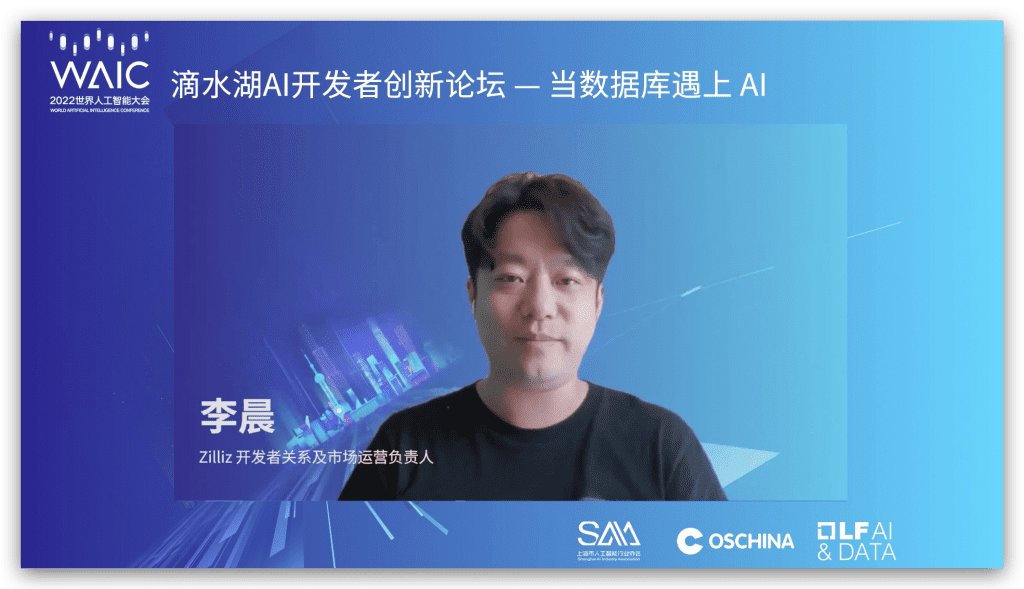The current application of AI is ubiquitous, and in the database field, if combined with AI, can database indexes and AI further reduce costs and increase efficiency? Can database storage plus AI further compress space? Can database operations plus AI further automate and improve security? Even when the database is coupled with AI, can it directly have a decision-making impact on the business? When the database meets AI, what kind of sparks can it produce?
From September 1st to 3rd, the WAIC 2022 World Artificial Intelligence Conference was successfully held. At the “Dishui Lake AI Developer Innovation Forum – When Database Meets AI” held on the 3rd, a group of speakers brought wonderful sharing. , to answer questions for the participants.
The guiding unit of this forum is the Office of the Organizing Committee of the World Artificial Intelligence Conference, sponsored by the Shanghai Artificial Intelligence Industry Association, and jointly organized by Open Source China (News Fast Delivery) and the LF AI & DATA Foundation.

The event was hosted by Li Chen, Head of Developer Relations and Marketing Operations at Zilliz.Du Junping, Chairman of the Board of Directors of LF AI & DATA, first brought the sharing of “LF AI & DATA Chinese Community, Leading the New Pattern of Global Open Source AI with Open Innovation”.Du Junping introduced the current development and distribution of AI from a global perspective. He said that China, the United States and Europe are currently leading the development of global AI. In the field of Internet, China and the United States have large Internet companies and rich applications and users, so they are relatively in this field. Leading; China and the United States also lead the world in autonomous driving in terms of smart city transportation; in the field of financial services, the United States has more financial innovations; and in the field of smart manufacturing, Europe and China, as manufacturing giants, lead the trend more; In terms of management, there are more innovative attempts to optimize enterprise process management through AI. Behind these, AI talents are an important foundation.

Du Junping introduced that the vision of LF AI & DATA Chinese community is to unite China’s AI community and use the LF AI & DATA open source platform
Join hands with global AI talents, so that the Chinese AI community can become an important force leading the development of global AI, so that more Chinese AI projects and enterprises can go to the world. He introduced a series of open source projects and communities that have achieved excellent results in the community, including ADLIK, Angel, DELTA, EDL, FATE, FlagAI, Milvus, OpenBytes and OpenDatalogy. At the same time, he said that the Chinese community has also established the MLOps Committee to jointly promote the implementation of AI engineering. The LF AI & DATA community set sail in China and went to the world. Du Junping welcomes the world’s love of AI technology, and the original enthusiasm of the small partners to join together, to contribute more collective wisdom, so that China’s AI industry and AI technology can lead the world.

Zheng Zhao, vice president of R&D and head of basic technology at 4Paradigm, shared OpenMLDB, a database for machine learning, he introduced the two major application types of AI: perception and decision-making. Among them, the decision-making field in which OpenMLDB is located represents feature extraction and machine learning models. General applications include risk control, recommendation systems, etc. Zheng Zhao said that in this type of decision-making application, in order to obtain models with high business value, there is a strong demand for real-time features. However, feature calculation scripts built by data scientists cannot be launched directly because they cannot meet production-level features such as low latency, high throughput, and high availability. In order to launch feature scripts for model inference in the production environment and meet the performance requirements of real-time computing, the engineering team often needs to refactor and optimize the code. Then, since two teams and two systems participate in the whole process from offline development to deployment and online, online and offline consistency verification has become an essential step, which often requires a lot of communication costs, development costs and testing. cost. Zheng Zhao introduced the overall architecture design of OpenMLDB in detail, and said that it is precisely to achieve the process optimization goal of the feature platform from development to deployment: development is launched immediately, so as to greatly reduce the landing cost of artificial intelligence.

The third topic is about unstructured data. Nowadays, unstructured data can be seen everywhere. Unlike structured data, we generally cannot use relational databases to store these unstructured data. At this time, a new direction has emerged. : Vector database. The development momentum of vector database in recent years is not small, and there are also some developments in China.Zilliz partner and technical director Luan Xiaofan brought a sharing of “The Evolution of Cloud Native Vector Database Milvus”.

Luan Xiaofan introduced the concept, current situation and pain points of vector retrieval, and took the application scenario practice of Milvus as an example, and shared strategies to deal with challenges. Finally, he also introduced the surrounding ecology of Zilliz vector database, including unstructured data ETL platform Towhee, vector data Visualization tool Feder, Milvus GUI management tool Attu.

Li Guoliang, a professor at the Department of Computer Science of Tsinghua University, shared “Research and Challenges of Autonomous Databases”.

When the database encounters AI, it will have two major impacts, one is AI for DB, the other is DB for AI, that is, the two influence each other and bring new capabilities. Li Guoliang introduced the mutual assistance between the two, and proposed the concept of “end-to-end autonomous database system”, and introduced the challenges encountered in building such a database system, including model selection, model verification, model Management of training data and training data; at the same time, it introduces in detail the specific architecture and logic of designing an autonomous database system to deal with challenges. Finally, the end-to-end autonomous database openGauss and its follow-up development plan are guided.


nextMeng Wei, Director of Standards and Open Source Strategy of ZTE, brought “Application of Open Source in the Field of AI for 5G”share.

On the surface, this has nothing to do with the AI database, but in fact the two have many things in common, such as intelligent operation and maintenance, intelligent classification, processing of large amounts of data, etc. Meng Wei introduced the engine that constitutes AI for 5G: standard + open source + Industry Alliance, his sharing allows us to try to look at “database + AI” from another perspective and learn from it.

Tencent Cloud Database also has profound exploration and accumulation in the direction of AI.The sharing theme brought by Cheng Bin, head of Tencent Cloud Database Technology, is “Tencent Cloud Database Intelligent Technology Practice”.

Cheng Bin introduced that the challenges faced by traditional cloud databases under the software + hardware architecture are mainly reflected in two aspects. On the one hand, cloud manufacturers need to solve the problems of availability guarantee, efficiency improvement and cost optimization. For enterprises, development efficiency, Operational efficiency and cost challenges are what they need to consider. Today, in addition to software and hardware, coupled with AI capabilities, Trinity can build a cloud-native autonomous database system to meet the challenges encountered in the past.
Cheng Bin took the practice of Tencent Cloud Database as an example, and analyzed how to design a self-analysis and self-evolving cloud from the three major aspects of business efficiency, operational efficiency and system efficiency, as well as the specific architecture and strategy details of each aspect. Native Autonomous Database System.

This forum also has a specialRoundtable “Rooted AI and Database”a number of experts gathered together to exchange discussions, allowing the audience to have a more comprehensive understanding of this cutting-edge topic.
The roundtable guests included Du Junping, Chairman of the Board of Directors of LF AI & DATA, Huang Kaiyao, Chief Architect of openGauss Open Source Database, Zheng Zhao, Director of LF AI & DATA, Luan Xiaofan, member of the Technical Advisory Committee of LF AI & DATA Foundation, and Meng Wei, Director of LF AI & DATA. Li Chen, head of developer relations and market operations at Zilliz, moderated the event.

The guests at the round table discussed the concept of AI database, the current development of AI database in the industry at home and abroad, technology and market, what aspects of the problem the AI database mainly solves, and the What technical difficulties will be encountered in the process of developing an AI database.

The last part,Yang Xuan, director of business development in the Asia-Pacific region of the Linux Foundation, brought the closing speech of the forumhe said that in the LF AI & DATA Foundation, the Chinese community has achieved very good results.Technical Advisory Committee) have more than half of the right to speak. Yang Xuan called on more Chinese AI companies to join the LF AI & DATA Chinese community, let more AI talents from around the world join, and make China an important force leading the development of global AI.
The forum is full of dry goods, please check the live replay:

#Database #Unlimited #Imagination #WAIC #World #Artificial #Intelligence #Conference #Dishui #Lake #Developer #Innovation #Forum #Database #Meets #Successfully #Concluded #News Fast Delivery
